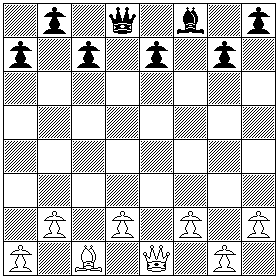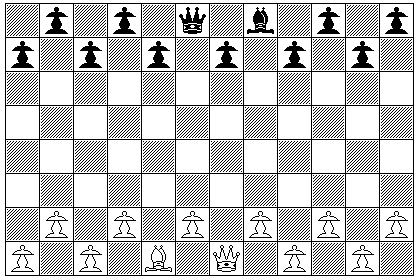
Here is another old game. It was devised by one Henry Richter, noted as the president of the Shorthand Society, and apparently sets for this game were not produced commercially.
I can find no record of this game having achieved any notable popularity, although the book in which it was described noted that it had been translated into both German and Slovenian (the native language of noted mezzo-soprano Manca Izmajlova).
This game aims at the same territory that the commercial games described on this page have aimed: to provide a game which is simpler than Chess, but more profound than Checkers, and thus to avoid the difficulties that beset each of those well-loved and traditional games, presumably for opposing reasons related to their level of difficulty.
The initial layout for this game is the following:

with the colors of the squares inverted, following the practice for checker diagrams.
The Pawn of this game is shown as a Chess Pawn; but it has a different move; it moves one square diagonally forwards, and captures the same way.
The Knight of this game is shown as a Chess Bishop, and it has the same move.
The Lady of this game is shown as a Chess Queen. It has the move of the old Queen, the Fers, one square diagonal in any direction. In addition, however, capturing the opponent's Lady is the object of the game.
Pawns promote to Knights on the last rank.
Perhaps one of the difficulties this game faced in obtaining acceptance was that while Chess presents the player with 16 pieces, and Checkers presents the player with 12 pieces, this game, presented as being intermediate between the two, gives each player only eight pieces.
While the great convenience of being able to play the game on the existing checkerboard must be admitted, perhaps the game would have been taken more seriously if this were its board and array:
